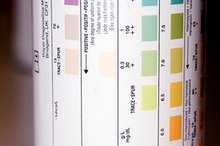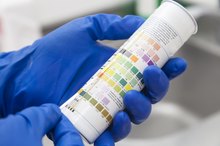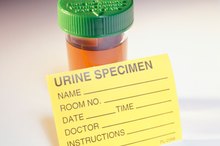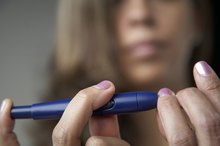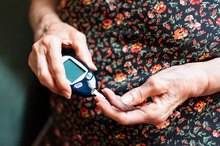How to Interpret Dipstick Urinalysis Results
Dipstick urinalysis is an easy, inexpensive way to see check for certain problems with your bladder and kidneys, as well as some problems with the digestive system. Over-the-counter urine dipsticks typically have between two and 10 chemical test squares, which may include pH, specific gravity, leukocytes, nitrites, protein, glucose, ketones, urobilinogen, bilirubin and blood. The results of each test are interpreted as normal or possibly abnormal. Talk with your doctor if you have any abnormal results on a dipstick urinalysis.
Specific Gravity and pH
Specific gravity is a general measure of how concentrated the urine is. Specific gravity is normally 1.003 to 1.030 and is influenced by how hydrated a person is. High values may indicate dehydration. Low values may indicate poor kidney function. Urine pH reflects how acidic or alkaline the urine is. Normal values are 4.6 to 8.0. A high pH may indicate a urinary tract infection, kidney problem or a pH imbalance in the bloodstream.
- Specific gravity is a general measure of how concentrated the urine is.
- Specific gravity is normally 1.003 to 1.030 and is influenced by how hydrated a person is.
Leukocytes and Nitrites
How to Read a Urinalysis
Learn More
Leukocytes are white blood cells, which are not normally found in urine. Any white blood cells could indicate an infection or another problem in the urinary tract. Nitrites are chemicals produced by certain types of bacteria, such E. coli. The presence of nitrites usually indicates an infection of the urinary system.
- Leukocytes are white blood cells, which are not normally found in urine.
- The presence of nitrites usually indicates an infection of the urinary system.
Glucose and Ketones
Glucose is blood sugar, which is not normally not found in urine. Glucose in the urine is often a sign of diabetes, although there are other possible causes. Ketones are a product of fat breakdown and are not typically found in the urine. Their presence may indicate poorly controlled diabetes. Ketones may also be present with fasting, dieting, prolonged vomiting or other metabolic problems.
- Glucose is blood sugar, which is not normally not found in urine.
- Ketones are a product of fat breakdown and are not typically found in the urine.
Blood and Protein
Color of Urine Strips for Ketosis
Learn More
Blood is not normally present in the urine. Bleeding in the urinary system is often due to an infection or kidney stone 3. Menstrual blood can also contaminate the urine and cause a positive test. Protein is normally not found in urine. The presence of protein in the urine may indicate a urinary tract infection or kidney problem.
- Blood is not normally present in the urine.
Bilirubin and Urobilinogen
Bilirubin and urobilinogen are byproducts of the normal breakdown of red blood cells. These chemicals are not normally found in urine. The presence of bilirubin or urobilinogen in the urine may indicate abnormally increased breakdown of red blood cells, liver disease or a blockage of bile flow into the intestines.
A Word of Caution
A dipstick urinalysis is a preliminary test and a number of factors can potentially interfere with the accuracy of the results 3. For example, certain medications, high amounts of vitamin C and even some foods that change the color of your urine may lead to inaccurate results.
Related Articles
References
- Emergency Medicine News: Urine Dipstick Testing: Everything You Need to Know
- American Family Physician: Urinalysis: A Comprehensive Review
- Graff's Textbook of Routine Urinalysis and Body Fluids, Second Edition; Lillian A. Mundt and Kristy Shanahan
- American Urological Association. Diagnosis, Evaluation and Follow-up of Asymptomatic Microhematuria (AMH) in Adults. 2016.
- Urinalysis. Visual Examination. Lab Tests Online. https://labtestsonline.org/understanding/analytes/urinalysis/ui-exams
- Perrier ET, Johnson EC, McKenzie AL, Ellis LA, Armstrong LE. Urine colour change as an indicator of change in daily water intake: a quantitative analysis. Eur J Nutr. 2016;55(5):1943–1949. doi:10.1007/s00394-015-1010-2
- Cortes-Penfield NW, Trautner BW, Jump RLP. Urinary Tract Infection and Asymptomatic Bacteriuria in Older Adults. Infect Dis Clin North Am. 2017;31(4):673–688. doi:10.1016/j.idc.2017.07.002
- Dreger NM, Degener S, Ahmad-Nejad P, Wöbker G, Roth S. Urosepsis--Etiology, Diagnosis, and Treatment. Dtsch Arztebl Int. 2015;112(49):837–848. doi:10.3238/arztebl.2015.0837
- Jump RL, Crnich CJ, Nace DA. Cloudy, Foul-Smelling Urine Not a Criteria for Diagnosis of Urinary Tract Infection in Older Adults. J Am Med Dir Assoc. 2016;17(8):754. doi:10.1016/j.jamda.2016.04.009
- Kang KK, Choi JR, Song JY, et al. Clinical significance of subjective foamy urine. Chonnam Med J. 2012;48(3):164–168. doi:10.4068/cmj.2012.48.3.164
- Blackburn PR, Gass JM, Vairo FPE, et al. Maple syrup urine disease: mechanisms and management. Appl Clin Genet. 2017;10:57–66. Published 2017 Sep 6. doi:10.2147/TACG.S125962
- Prakash S, Saini S, Mullick P, Pawar M. Green urine: A cause for concern?. J Anaesthesiol Clin Pharmacol. 2017;33(1):128–130. doi:10.4103/0970-9185.202190
- Torres PA, Helmstetter JA, Kaye AM, Kaye AD. Rhabdomyolysis: pathogenesis, diagnosis, and treatment. Ochsner J. 2015;15(1):58–69. PMID: 25829882
- Rehfuss A, Mahon J, Sorokin I, Smith C, Stein BS. Phenazopyridine: A Preoperative Way to Identify Ureteral Orifices. Urology. 2018;115:36-38. doi:10.1016/j.urology.2018.02.023
- American Urological Association. Diagnosis, Evaluation and Follow-up of Asymptomatic Microhematuria (AMH) in Adults. 2016.
- Worku DA. Purple urine bag syndrome: An unusual but important manifestation of urinary tract infection. Case report and literature review. SAGE Open Med Case Rep. 2019;7:2050313X18823105. Published 2019 Jan 12. doi:10.1177/2050313X18823105
- Alkaptonuria. National Institutes of Health. Genetic and Rare Diseases Information Center. 3/18/2016
- Seo JW, Lee JH, Son IS, et al. Acute oxalate nephropathy caused by ethylene glycol poisoning. Kidney Res Clin Pract. 2012;31(4):249–252. doi:10.1016/j.krcp.2012.09.007
- Urinalysis. Visual Examination. Lab Tests Online.
Writer Bio
Based in Brooklyn since 2007, Asal Sepassi has been in health education for nearly two decades. She holds an MD and an MBA, and believes that knowledge is the basis for good health.

